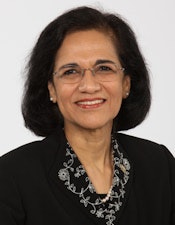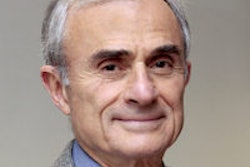
In this two-part series, Dr. David C. Levin and Dr. Vijay Rao of Thomas Jefferson University outline actions that radiologists can take to address threats to the specialty. In part 1, Rao outlines 12 steps that radiologists can take to protect themselves.
Radiology is facing threats from all sides. Declining reimbursement, the move toward new payment models, bundling of CPT codes, commoditization, and increasing service demands from hospitals are just a few.
And with the perception on Capitol Hill that a large percentage of imaging is unnecessary, federal legislation continues to crack down on utilization -- with blunt, across-the-board cuts rather than more effective measures.
 Dr. Vijay Rao.
Dr. Vijay Rao.
However, radiologists can take action to address these threats, according to a presentation given at RSNA 2012 by Dr. Vijay Rao and Dr. David C. Levin of Thomas Jefferson University. What's crucial is to take action: The time for standing by is over, Rao said.
"In the past, we might have told ourselves, 'We're such a big practice, we've been [at the hospital] for years, we do a great job -- our hospital is not going to get rid of us,' " she said. "But things are changing."
Rao outlined 12 actions radiologists can take to protect the specialty.
- Take back the night. "Do not outsource to teleradiology companies, and don't work for them," Rao said. "Groups need to be hiring their own people to provide night and emergency services. We're sleeping well at night, but these companies are going directly to hospitals and ousting radiology groups. Pretty soon we'll be able to sleep during the day, too."
- Consolidate. If smaller groups can't offer 24/7 service, they should consider consolidating into larger groups, Rao said. "Consolidating gives groups more market power and economies of scale in billing, purchasing, insurance, and human resources."
- Freestanding practices, beware. "If you're in a freestanding practice with no hospital affiliation, beware," Rao cautioned. "With the advent of new models of care, this type of practice is probably threatened. Think about becoming affiliated with a hospital, or a larger, multispecialty group."
- Build bridges to hospital administration. "We're hearing so much about how relationships between hospitals and radiologists are increasingly strained," Rao said. "Don't just sit in the reading rooms and churn out reports. Get a spot on hospital committees -- medical staff, executive, quality and safety -- and participate. Get involved in the hospital's strategic planning, marketing, and fundraising. Just as we need to be visible to our patients, we also need to be visible to hospital administrators."
- Take on more responsibility: The more radiologists work with hospital administration, the less chance of being ousted. "Take on more responsibility for managing your hospital's radiology department -- and ask to get paid for it," Rao said. "Payment could be a management fee, or part of the technical component for hospital outpatient. Create financial targets and agree that if the department meets them, it will get portion of savings."
- Embrace efforts to control utilization of imaging, perhaps through decision-support systems linked to order entry. "It's the right thing to do," Rao said. "Will it affect our pocketbooks? Yes, absolutely, but we need to do the right thing for our patients." Radiologists should look at their own ordering patterns as well, Rao said, and evaluate whether they are recommending studies that aren't necessary.
- Publicize and use American College of Radiology (ACR) appropriateness criteria. "Radiology hasn't done a good job of putting these criteria out there," Rao said. "We need to do this -- to publish outside of radiology journals, in other clinical journals."
- Build bridges to primary care physicians. "Primary care physicians are going to have a bigger and bigger role in healthcare," Rao said. "Between radiologists and primary care doctors, we can make 90% of diagnoses, without bringing in subspecialists. So start building relationships with them."
- Focus less on money and lifestyle. "We have an image problem, whether we like it or not," Rao said. "Radiologists are well-compensated in the medical hierarchy, and people think of us as sitting there with a cup of coffee and our feet on the desk. We know that's not true; radiologists work hard, there's no doubt about that. But nonetheless, we need to focus less on money and lifestyle -- it just makes us look bad."
- Focus on quality. "Every department or practice should be tracking quality metrics, whether it's on paper or electronically," Rao said. "Pick your metrics and share the results with your hospital. Get involved with peer review, get ACR accreditation, and participate in the [Physician Quality Reporting Initiative (PQRI)] program. And if you have a robust quality assurance program, insist to the hospital that any other specialist who wants to do imaging should have one, too -- all imaging performed in the hospital should be tracked and reviewed."
- Research. "The specialty that does research controls that specialty," Rao said. "If we want to be considered a specialty, not a commodity, we need to do research. Either do it yourself or support it."
- Promote the idea of radiology as a service line. "Hospitals are now creating service lines -- cancer, cardiovascular, gastrointestinal, orthopedics, neurosciences," Rao said. "Radiology works on a horizontal matrix, so the influence of radiology on capital allocation can be diminished as the service lines now recommend what equipment is needed. Be careful about that, and remember that the highest contribution margin to hospitals for the outpatient market is radiology -- 37%."
The threats to radiology can seem daunting, but it won't help to ignore them, Rao concluded.
"We can't bury our heads in the sand," she said. "We really need leadership in radiology to address these challenges."




















